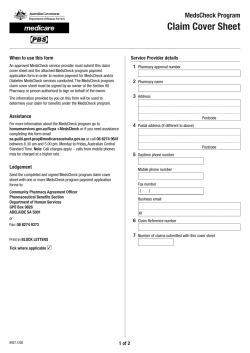
Briefing Investment Funds PAIF tension between property funds and platforms October 2014
Briefing Investment Funds October 2014 PAIF tension between property funds and platforms As Property Authorised Investment Funds (“PAIFs”) become Other taxable income, the second category of income increasingly popular, the Tax Incentivised Savings Association distributions, is treated for tax purposes as if the distribution has reported on what it describes as a growing tension were a payment of yearly interest. This is generally paid to between industry bodies that are keen to take advantage of the corporation tax payers without any deduction for tax, but for available tax advantages of the PAIF structure, and platforms’ income tax payers is paid net of tax at the basic rate. failure to support these funds. PAIFs generally Where an open-ended investment company (“OEIC”) invests in a portfolio that comprises predominantly real property or shares in UK Real Estate Investment Trusts (UK-REITS) and certain Finally, dividend income distributions are exempt from corporation tax and, for income tax, carry a one-ninth nonrepayable tax credit which satisfies basic rate tax liabilities, but which requires payment of an additional amount by higher rate taxpayers. similar entities it can, subject to satisfying a number of other Other tax benefits include no capital gains tax for investors conditions, elect to be authorised as a PAIF. and an exemption from stamp duty land tax (“SDLT”) on the The main benefits to funds and their investors of the PAIF regime are tax related. Generally, investors are taxed as if they had invested directly in the underlying assets and therefore conversion of an existing authorised fund into a PAIF. The government is consulting on extending the SDLT exemption to the conversion of an unauthorised fund into a PAIF. receive benefits not otherwise available to most other collective As a result of this beneficial tax regime, PAIFs have fast become investment schemes that invest in rental property. These tax the preferred structure for property portfolios. Recent notable benefits are achieved by ring fencing income received from the conversions to the PAIF structure have been the £3.4bn M&G fund’s property investment business, (e.g. rentals) and then Property Portfolio, the £986m Standard Life Investments UK splitting the remaining types of income between “other taxable Property fund and the £1.4bn L&G UK Property trust. income” (e.g. interest and taxable dividends) and exempt However, the perceived lack of interest from platforms to dividend income. Investors, therefore, receive three different introduce support for PAIFs has proved frustrating for the types of income, each of which is taxed differently – a structure industry, the Treasury and HMRC, with the Chief Executive of that is designed to separate retail investors from corporate the Association of Real Estate Funds, John Cartwright, recently holders. The net result of this, however, is that platforms calling for platforms to take up the interest in PAIFs and to struggle to cope with the administrative burden of accounting properly implement them into their systems. for each type of income received and distributed by the funds. Taxation of PAIF distributions The three different types of PAIF distributions are as follows: Property income distributions (“PIDs”) are taxable as the income of a UK property business. These PIDs are paid to income tax paying investors net of tax at the basic rate (thereby creating an extra liability for higher rate taxpayers). PIDs are also chargeable to corporation tax in the hands of a corporation tax payer, though the taxpayer in this instance will receive the PID in gross form. The timing would seem to be right, with PAIFs poised to become increasingly popular as real estate investment continues to increase with net retail sales of £242m in August 2014. Burges Salmon advised on the incorporation of the first authorised PAIF and our Funds team regularly advises on the authorisation and ongoing management of regulated funds. If you would like advice on the above or with regards to PAIFs generally please contact Nigel Popplewell, Tom Dunn, Nicola Manclark or Victor Ondoro. continued overleaf Contacts For further information, please contact: Nigel Popplewell Tom Dunn Partner, Tax Partner, Funds +44(0)117 902 2782 +44(0)117 902 7796 nigel.popplewell@burges-salmon.com tom.dunn@burges-salmon.com Nicola Manclark Victor Ondoro Senior Associate, Tax Consultant, Funds +44(0)117 902 2743 +44(0)117 307 6051 nicola.manclark@burges-salmon.com victor.ondoro@burges-salmon.com Burges Salmon LLP, One Glass Wharf, Bristol BS2 0ZX Tel: +44 (0) 117 939 2000 Fax: +44 (0) 117 902 4400 6 New Street Square, London EC4A 3BF Tel: +44 (0) 20 7685 1200 Fax: +44 (0) 20 7980 4966 www.burges-salmon.com Burges Salmon LLP is a Limited Liability Partnership registered in England and Wales (LLP number OC307212) and is authorised and regulated by the Solicitors Regulation Authority. A list of members, all of whom are solicitors, may be inspected at our registered office: One Glass Wharf, Bristol BS2 0ZX. © Burges Salmon LLP 2014. All rights reserved. Extracts may be reproduced with our prior consent, provided that the source is acknowledged. Disclaimer: This briefing gives general information only and is not intended to be an exhaustive statement of the law. Although we have taken care over the information, you should not rely on it as legal advice. We do not accept any liability to anyone who does rely on its content. Data Protection: Your details are processed and kept securely in accordance with the Data Protection Act 1998. We may use your personal information to send information to you about our products and services, newsletters and legal updates; to invite you to our training seminars and other events; and for analysis including generation of marketing reports. To help us keep our database up to date, please let us know if your contact details change or if you do not want to receive any further marketing material by contacting marketing@burges-salmon.com. BRM0829 10 14
© Copyright 2025









